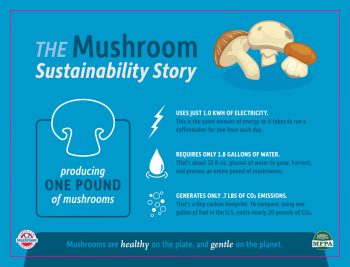 AVONDALE — Growing mushrooms is a mystery to most people. Because they are grown in indoor growing houses, you don’t see them in field. But this growing process is just part of what makes mushrooms one of the most sustainable foods. The mushroom growing process – including the mushroom sustainability story – will be on full display at the 2020 PA Farm Show, which opens today and runs through Jan. 11, at the Farm Show Complex in Harrisburg, PA.
AVONDALE — Growing mushrooms is a mystery to most people. Because they are grown in indoor growing houses, you don’t see them in field. But this growing process is just part of what makes mushrooms one of the most sustainable foods. The mushroom growing process – including the mushroom sustainability story – will be on full display at the 2020 PA Farm Show, which opens today and runs through Jan. 11, at the Farm Show Complex in Harrisburg, PA.
Mushroom growers are known as the ‘ultimate recyclers.’ From the beginning of the process – compost preparation – to post harvest, mushroom farmers are great stewards of the earth, using and reusing the natural materials needed to grow mushrooms. Because of this recycling of other agricultural crops and byproducts, mushroom farms have a smaller environmental footprint than almost any other farms.
“When you go into the store and see white or brown “button” mushrooms, you are looking at an incredibly efficient food,” explained Meghan Klotzbach, chair, Mushroom Farmers of Pennsylvania, part of the American Mushroom Institute.
Efficient Water Management
Today’s growers use smart management and production practices that use less than 2 gallons of water to produce one pound of button mushrooms – that’s about 32 (8 oz) glasses of water to grow, harvest, and process an entire pound of mushrooms, compared with an average of 50 gallons of water per pound of other fresh produce items.
Low-Energy Output
Mushrooms are a fairly low-energy footprint crop. Producing one pound of button mushrooms takes 1.0 kilowatt hour (kwh) of electricity. This is the same amount of energy (1 kwh) as it takes to run a coffeemaker for one hour each day! Because of the way mushrooms are grown, being smart about energy use is good for production AND good for the environment.
Minimal Greenhouse Gas
Growing that one pound of mushrooms is so efficient, in fact, that it generates just 0.7 pounds of CO2 equivalents. This means if you added up all the emissions of carbon dioxide (CO2, a greenhouse gas) from producing that one pound of button mushrooms – from the compost recipe all the way through to what you purchase in the store – it is the equivalent of just 0.7 pounds of CO2. To give some perspective of how small a carbon footprint that is, using one gallon of fuel in the U.S. emits nearly 20 pounds of CO2.
Small Land Mass
Mushrooms produce high yields from a very small physical footprint. One acre of land can produce 1 million pounds of mushrooms. In 2017-18, mushroom growers sold 917 million pounds of Agaricus mushrooms. Put another way, one acre of land can produce enough mushrooms to fill the length of nearly 4,700 football stadiums. Even more, 917 million pounds of mushrooms is enough to circle the circumference of the globe mushroom cap to mushroom cap 19 times!
From an environmental perspective, mushrooms farmers are progressive stewards of the land, water, soil, and air, explained American Mushroom Institute President Rachel Roberts. “As consumers look to make food decisions that take environmental impacts and carbon footprint into account, mushrooms are a choice that everyone can feel good about.”
For more information about sustainability in the mushroom industry, visit https://www.americanmushroom.org/main/sustainability/






